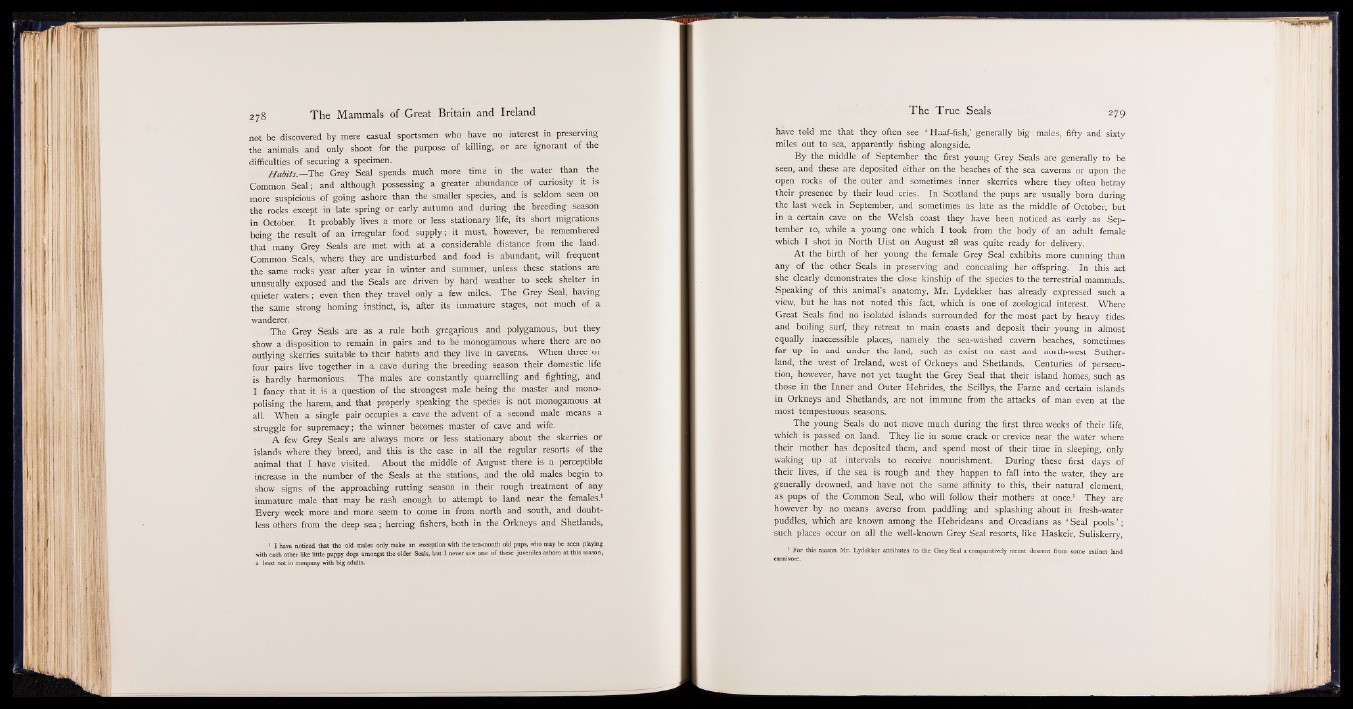
not be discovered by mere casual sportsmen who have no interest in preserving
the animals and only shoot for the purpose of killing, or are ignorant of the
difficulties of securing a specimen.
H abits— lb s Grey Seal spends much more time in the water than the
Common Seal; and although possessing a greater abundance of curiosity it is
more suspicious of going ashore than the smaller species, and is seldom seen on
the rocks except in late spring or early autumn and during the breeding season
in October. It probably lives a more or less stationary life, its short migrations
being the result of an irregular food supply; it must, however, be remembered
that many Grey Seals are met with at a considerable distance from the land.
Common Seals, where they are undisturbed and food § | abundant, will frequent
the same rocks year after year in winter and summer, unless these stations are
unusually exposed and the: Seals are driven by hard weather to seek shelter in
quieter waters; even then they travel only a few miles. The Grey Seal, having
the same strong homing instinct, is,, after its immature stages, not much of a
wanderer.
The Grey Seals are as a rule both gregarious and polygamous, but they
show a disposition to remain in pairs and to be monogamous where there are no
outlying skerries suitable to their habits and they live in caverns. When three or
four pairSSilive together in a cave during the breeding season their domestic life
is hardly harmonious. . The males are constantly quarrelling and fighting, and
I fancy that it is a question of the strongest male being the master and monopolising
the harem, and that properly speaking the species is not monogamous at
all. When a single pair occupies a cave the advent of a second male means
struggle for supremacy; the winner becomes master of cave and wife.
: A few Grey Seals are always more or less stationary about the skerries or
islands where they breed, and this is the case in all the regular resorts of the
animal that I have visited. About the middle of August there is a perceptible
increase in the number of the Seals at the stations, and the old males begin to
show signs of the approaching rutting season in their rough treatment of any
Immature male that may be rash enough to attempt. to land near the females.1
Every week more and. more seem to .come in from north and south, and doubtless
others from the deep sea; herring fishers, both in the Orkneys and Shetlands,
1 I have noticed that the old males only mate an exception with the ten-month old pups, who may be seen playing
with each other like little puppy dogs amongst the older Seals, but I never saw one of these juveniles ashore at this season,
a least not in company with big adults.
have told me that they often see ‘ Haaf-fish,’ generally big males, fifty and sixty
miles out to sea, apparently fishing alongside.
By the middle of September the first young Grey Seals are generally to be
seen, and these are deposited either on the beaches of the sea caverns or upon the
open rocks of the outer and sometimes inner skerries where they often betray
their presence by their loud cries. In Scotland the pups are usually born during
the last week in September, and sometimes as late as the middle of October, but
in a certain cave on the Welsh coast they have been noticed as early as September
io, while a young one which I took from the body of an adult female
which I shot in North Uist on August 28 was quite ready for delivery.
At the birth of her young the female Grey Seal exhibits more cunning than
any of the other Seals in preserving and concealing her offspring. In this act
she clearly demonstrates the close kinship of the species to the terrestrial mammals.
Speaking of this animal’s anatomy, Mr. Lydekker has already expressed such a
view, but he has not noted this fact, which is one of zoological interest. Where
Great Seals find no isolated islands surrounded for the most part by heavy tides
and boiling surf, they retreat to main coasts and deposit their young in almost
equally inaccessible places, namely the sea-washed cavern beaches, sometimes
far up in and under the land, such as exist on east and north-west Sutherland,
the west of Ireland, west of Orkneys and Shetlands. Centuries of persecution,
however, have not yet taught the Grey Seal that their island homes, such as
those in the Inner and Outer Hebrides, the Scillys, the Fame and certain islands
in Orkneys and Shetlands, are not immune from the attacks of man even at the
most tempestuous seasons.
The young Seals do not move much during the first three weeks of their life,
which is passed on land. They lie in some crack or crevice near the water where
their mother has deposited them, and spend most of their time in sleeping, only
waking up at intervals to receive nourishment. During these first days of
their lives, if the sea is rough and they happen to fall into the water, they are
generally drowned, and have not the same affinity to this, their natural element,
as pups of the Common Seal, who will follow their mothers at once.1 They are
however by no means averse from paddling and splashing about in fresh-water
puddles, which are known among the Hebrideans and Orcadians as ‘ Seal pools ’ ;
such places occur on all the well-known Grey Seal resorts, like Haskeir, Suliskerry,
1 For this reason Mr. Lydekker attributes to the Grey Seal a comparatively recent descent from some pvHnrt land
carnivore.